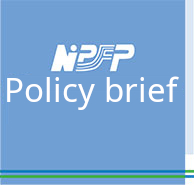Fiscal Multipliers for India
SUKANYA BOSE, Associate Professor, National Institute of Public Finance and Policy, New Delhi, India. email:sukanya.bose@nipfp.org.in
|
The concept of fiscal multiplier – the short run effects of a unit change in government spending or tax on economic activity - is core to the debates on fiscal stimulus and consolidation.
The “size” of the fiscal multiplier has become central to the debates related to magnitude and timing of fiscal stimulus and reversals in the post-Crisis period. India has undertaken fiscal stimulus measures following the global financial crisis. However, these stimulus measures were largely adhoc and arbitrary. Many of these measures related to public spending were introduced even before the crisis set in. There was conspicuous absence of ex-ante fiscal multiplier analysis to understand the impact of such stimulus on reviving demand.
Bose and Bhanumurthy (2013) – on which this One Pager is based – is the first attempt to systematically estimate the size of fiscal multipliers for India. The structural macro-econometric model - on which the study is based- allows for separate treatment of revenue and capital components of combined government (Centre and States) spending. The model has also disaggregated transfer payments from other components of revenue expenditure. This disaggregation of public spending is crucial to capture the various macroeconomic channels through which fiscal stimulus affects aggregate demand.
A priori, the fiscal multipliers capture the magnitude of the impact of discretionary fiscal policy on short run macroeconomic stabilization. There are two plausible channels through which public spending can affect aggregate demand. First, the change in the public investment (capital spending) can private investments. Second, the public spending crowds-in or crowds-out private consumption.
The model generates strikingly different values for capital and revenue spending multipliers. A value of 2.45 for capital expenditure multiplier translates to a strong impact of public investment on economic activity. The revenue expenditure multipliers are below unity. The transfer payments multiplier – which constitutes the effects of subsidies, pensions and other retirement benefits on output– has an impact multiplier of 0.98, while the multiplier constructed on the “other” revenue expenditure components is 0.99.
A digression is inevitable here to explain the difference between impact multiplier and cumulative multiplier. The impact multiplier is the ratio of change in output to a change in spending, exclusively for the period ‘t’ in which the fiscal stimulus occurs. The cumulative multiplier captures the effects |
of fiscal stimulus over longer forecast horizons. It measures the cumulative change in economic activity per unit of incremental governmental spending, for the entire forecast period. The cumulative multiplier for capital spending is even higher at 4.8 per cent (see table 1). This result has significant policy implications.
Note: Cumulative multipliers for over a period of 7 years
From a policy perspective, high revenue deficits have often compressed capital expenditure, and/or caused a breach in targeted fiscal deficit to GDP ratio, where the latter has been bound by fiscal rules through the Fiscal Responsibility and Budget Management Act, 2003. Revenue deficit as a proportion of GDP rose in the post-crisis years, partly because of a dip in revenue receipts, and has yet to return to the levels attained in 2007-08. Capital expenditure of the combined government spending has hovered around 4 percent of GDP, way below the targets recommended by the Thirteenth Finance Commission.
In terms of policy, running higher revenue deficit (above the targeted level) and at the same time sticking to fiscal consolidation targets only result in decline in public capital expenditure (this seems to be the case in 2013-14 where fiscal deficit could be contained at 4.6% while there is a relaxation in revenue deficit target). In such circumstances, the simulation results suggest that the economy could experience negative revenue expenditure multipliers. Hence, sticking to revenue deficit target is the most crucial in the context of fiscal consolidation. At the same time any relaxation of revenue deficit target should also result in relaxation of fiscal deficit target without compromising the public capital expenditure target. In other words, ring-fencing of capital expenditure target is most crucial for reviving growth in India.
Reference Bose, Sukanya, and N. R. Bhanumurthy, 2013. Fiscal Multipliers for India, Working Paper No. 125, NIPFP, New Delhi (September). |




